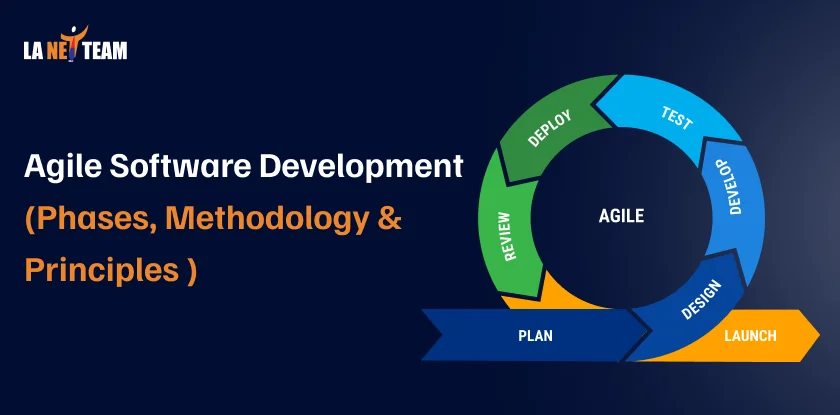When it comes to building software, time is important. That’s why teams need a way to move faster and adjust quickly when things change.
One of these ways is Agile software development.
Instead of waiting months to launch something big, Agile breaks the work into small steps called “sprints.” Each sprint delivers a working piece of the software, so customers see progress faster.
The best part? Agile handles changes really well. If users want a new feature or find a bug, the team can fix it in the next sprint instead of waiting for a big update later.
So, let’s dive in and learn about it more.
What is Agile Software Development?
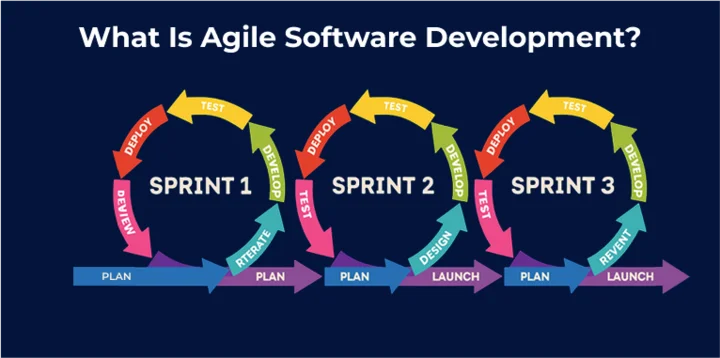
Agile software development is a step-by-step approach to build a software.
Teams work in small groups known as ‘Sprints’. Sprints are designed to work on a piece of software, allowing the customer to see the progress before the final product.
Also, agile enables quick adjustments and releases when someone requests a new feature, identifies a bug, or proposes a change.
Additionally, teams look at what users need, what’s been done, and what’s most important. This way, they don’t waste time building stuff nobody wants.
👉Check out what is software development life cycle is to understand the phases your project will go through.
Key Phases Of the Agile Software Development
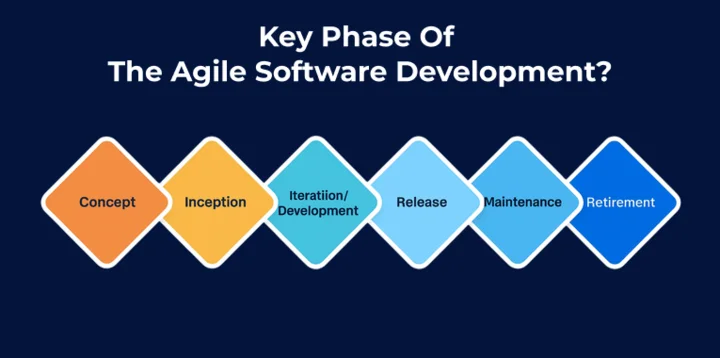
Below are the phases that will help make your software build easier and smoother.
- Concept: During this phase, the product owner and project stakeholders determine the scope of the project and business objectives.
- Inception phase: In this phase, the team gathers, prepares tools, and pre-conceives the initial design and architecture. This involves developing mockups or prototypes and working out requirements in response to stakeholder feedback. Hence, it ensures early alignment and smoother saas software development.
- Iteration/Development phase: This is the longest phase, where developers write code in short cycles (usually 2-4 weeks). Each iteration delivers a functional piece of software. Continuous integration and testing happen here to catch issues early.
- Release phase: After rigorous testing, the software is deployed to production. User training and documentation are prepared. This phase ensures the product is stable and ready for users.
- Maintenance phase:
After the product has gone live, the team corrects bugs and adds features, and continues to improve. User feedback would inform the next thing to build. - Retirement phase:
The software is retired when it is not up-to-date and its functionality is substituted by some other system. The users are transferred to the new platform, and the old platform’s support is shut down.
The Agile Manifesto: 4 Core Values You Need To Know
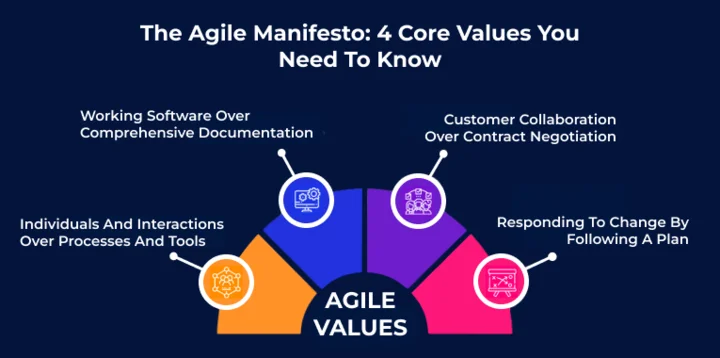
In 2001, a team of developers gathered together and developed the Agile Manifesto. It is simply a collection of principles to be used to streamline software development to be more responsive.
Here are 4 core values that were created to guide how we work today:
1. Individuals and interactions over processes and tools:
Project management tools like Jira are important. But they have no value if your team isn’t communicating properly. Tools won’t replace the need for real conversations.
Too often, teams hide behind tickets and miss out on the value of direct discussions. It’s the human connection and collaboration that get things done effectively.
2. Working software over comprehensive documentation:
Documentation is important, but having a working feature is even more valuable than perfect documentation for something that doesn’t work.
I’d rather have a functional feature with basic documentation than a huge document about software that’s still just an idea. Users want the product to work, not just read specifications.
3. Customer collaboration over contract negotiation:
Customers are not just there to fulfill a contract; they are partners in building the product. Their feedback helps you build something that actually solves real problems.
Working closely with them ensures the real problem is being solved rather than wasting money.
4. Responding to change by following a plan:
Plans are helpful, but things change a lot, especially in SaaS. Markets shift, customer needs grow, and new problems come up.
Flexibility is much more important than having a plan that is not working anymore.
Agile emphasizes real teamwork and rapid delivery, aligning perfectly with Rapid Application Development principles.
The 12 Principles of Agile Software Development
Beyond the 4 main values, the agile manifesto also has 12 important principles. Here are:
- Keep customers happy by delivering working software early and often.
- Accept changes in the project, even if they come late.
- Deliver working software regularly, every few weeks.
- Business people and developers should work together daily.
- Build projects with motivated people and trust them to do the job.
- Do face-to-face conversations whenever possible.
- Measure progress mainly by working software, not paperwork or hours.
- Keep a steady, sustainable work pace to avoid burnout.
- Focus on technical quality and good design continuously.
- Keep things simple and avoid unnecessary work.
- Let teams organize themselves to find the best ways to work.
- Regularly reflect on your work and improve continuously.
Agile Software Development Cycle: A Step-by-Step Breakdown
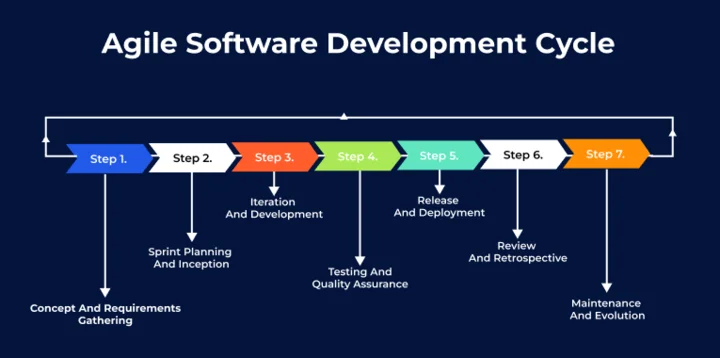
Let’s break down how Agile works. Teams may do things a bit differently, but here’s the usual flow:
Step 1: Concept and Requirements Gathering:
This is the first step, where you figure out what to build and why. Cross-functional teams get together and talk about user needs and market opportunities. Instead of long documents, we write simple user stories.
Did you know?
Almost 80 percent of all project failures are associated with a bad requirements gathering process, illustrating the importance of this initial step towards Agile success.
Step 2: Sprint Planning and Inception
Now we take those user stories and break them into tasks. We set clear sprint goals, decide what’s realistic, and assign work. It’s where we commit to what we’re delivering in the sprint.
And once the planning is done, it’s time to get moving….
Step 3: Iteration and Development
It is the building stage, where we constantly test and incorporate code to avoid last-minute chaos. This is where developers focus on coding, designers create the look, and everyone works together smoothly. Additionally, devOps as a service can automate deployments and speed up development.
Step 4: Testing and Quality Assurance
We don’t wait till the final step to test. Testing happens while we are building. But when testing is done by using modern software testing methodologies, it ensures that quality is best. Also, this helps:
- Developers write unit tests as they code
- Integration testing happens as pieces come together
- Real users test features before they go wide
- Automated tests keep things from breaking later
Step 5: Release and Deployment
Once a feature is ready, they are shipped. Teams use beta testing and feature flags to control rollouts. They watch the performance closely for any issues. Hence, this step makes sure features reach users quickly and safely.
Step 6: Review and Retrospective
Now, in this step, after development and release, the sprint comes to an end. Teams demo what they built and have an honest discussion about what worked and what didn’t. This helps the team improve for the next sprint.
Note: A sprint can be described as a limited duration of time, typically one to four weeks, during which a group of people is engaged in particular activities.
Step 7: Maintenance and Evolution
Finally, in this phase, there is the action of monitoring feature performance, fixing bugs, and improving upon the feedback of the users. The cycle goes on with each change being included in the next sprint.
Agile Methodology Comparison Table
| Methodology | Best For | Sprint Length | Team Size | Key Strength | Main Challenge |
|---|---|---|---|---|---|
| Scrum | Feature development | 2-4 weeks | 5-9 people | Predictable delivery | Can feel rigid |
| Kanban | Continuous flow work | N/A (continuous) | Any size | Flexibility | Less structure |
| XP | Technical excellence | 1-2 weeks | 2-12 people | Code quality | Intense practices |
| Hybrid | Unique team needs | Varies | Any size | Customization | Requires experience |
Types of Agile Methodologies
Agile is the philosophy, but you need a framework to actually implement it. Here are the methodologies below:
1. Scrum Framework:
The Scrum framework is what comes to mind when someone says ‘Agile’. This framework is associated with flexible and clear roles. Scrum works in fixed time periods called sprints, so everyone knows when to plan, review, and take a breather.
Perfect for: Teams developing new features or big projects where it is essential to plan and have a strong idea of when it will be delivered.
2. Kanban:
Kanban is all about seeing your work. You’ve got a board with columns like “To Do,” “In Progress,” and “Done,” and you move cards across as work progresses.
Perfect for: Teams that have to cope with tasks and urgent requests.
3. Extreme Programming (XP):
XP focuses on doing quality coding. It includes:
- Pair programming (two people work on one code)
- Test-driven development (test-driven development)
- Continuous integration (merging code often)
- Keep code simple and clean
Best for: Teams where great code matters, like SaaS companies.
👉To know more about it, read our blog on ‘Extreme Programming (XP).
4. Hybrid Approaches:
A hybrid approach, by the name state, is the mix of approaches. In short, it’s all about mixing and matching approaches that work best for the team.
An example of this is when some teams apply Scrum when dealing with big projects and Kanban when dealing with smaller tasks. The idea is to get the optimal match to the task you are supposed to work on.
Wrapping up
You are slowing down your growth unless you are using the Agile approach in your projects. Today’s customers expect faster updates, fewer bugs, and products that truly solve their problems.
Here are the reasons to choose agile:
- It aligns teams and stakeholders.
- Work in small and clear steps.
- Listen to feedback early.
But remember, when done rightly, agile improves speed, reduces risks, and builds stronger products. If you are just starting, check learn how to start a software development career to understand the skills and paths that align with Agile.
